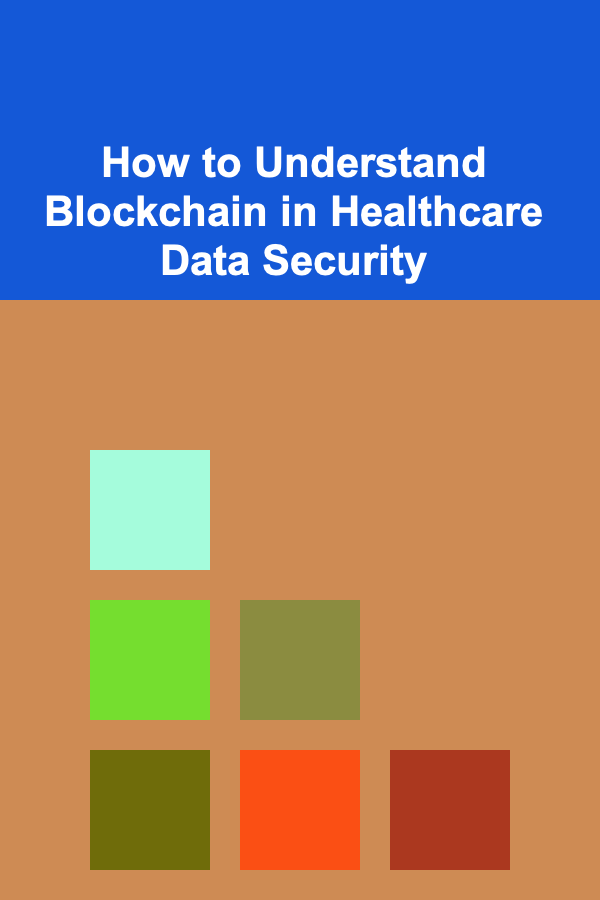
How to Understand Blockchain in Healthcare Data Security
ebook include PDF & Audio bundle (Micro Guide)
$12.99$7.99
Limited Time Offer! Order within the next:

In recent years, the healthcare industry has faced increasing challenges related to data security. With the growing use of electronic health records (EHRs) and other digital health solutions, ensuring the security and privacy of healthcare data has become a critical concern. Blockchain, a technology originally designed for cryptocurrency, has emerged as a promising solution to address these challenges. In this article, we will explore how blockchain can be applied to healthcare data security, discussing its principles, benefits, challenges, and potential use cases.
What is Blockchain?
Blockchain is a decentralized, distributed ledger technology that allows data to be stored across multiple computers in such a way that no single entity controls the information. This technology was initially created for Bitcoin and other cryptocurrencies, but its potential has since expanded to various industries, including healthcare.
The core concept of blockchain lies in its ability to create a secure and transparent record of transactions. These transactions are grouped into "blocks," which are linked together in chronological order, forming a "chain." Once a block is added to the chain, it is nearly impossible to alter, ensuring the integrity of the data stored within it.
Blockchain relies on cryptographic techniques to secure data. Each block contains a unique cryptographic hash of the previous block, ensuring that any changes to the data would require altering all subsequent blocks, which is computationally infeasible. This makes blockchain a highly secure and tamper-resistant technology.
Why is Data Security Crucial in Healthcare?
Healthcare data, such as medical records, personal health information (PHI), and insurance details, is highly sensitive. A breach of this data can have severe consequences, including identity theft, fraud, and a loss of patient trust. Additionally, the healthcare industry is a prime target for cyberattacks due to the valuable nature of the data it holds.
Healthcare data security is particularly challenging due to the following factors:
- Data Breaches: Healthcare organizations are often targeted by cybercriminals seeking to steal PHI for malicious purposes.
- Interoperability: Healthcare systems often involve multiple parties (hospitals, insurance companies, clinics), each of which needs access to the same data.
- Regulatory Compliance: Healthcare organizations must comply with regulations such as HIPAA (Health Insurance Portability and Accountability Act) in the U.S., which mandates strict security and privacy measures for healthcare data.
- Data Sharing: Healthcare professionals need to share patient data securely to provide effective care. However, sharing sensitive information between multiple entities can create vulnerabilities if not done properly.
Blockchain's unique characteristics make it an attractive solution for addressing these challenges in healthcare data security.
Blockchain's Role in Healthcare Data Security
Blockchain's application in healthcare data security can address several of the industry's key issues, such as data breaches, privacy, interoperability, and regulatory compliance. Below are the main ways blockchain enhances healthcare data security:
1. Decentralized Control and Ownership
One of the main strengths of blockchain is its decentralized nature. In a traditional centralized database, a single entity or organization controls the data, making it a potential target for cyberattacks. With blockchain, the data is distributed across a network of computers, meaning that no single entity has complete control over the information. This reduces the risk of hacking, as an attacker would need to compromise a significant portion of the network to alter the data.
In healthcare, this decentralization means that patients can have more control over their own medical data. Instead of relying on healthcare institutions to manage and store sensitive information, patients can store their data on a blockchain and grant access to authorized parties when needed. This creates a more patient-centered model of data ownership and access.
2. Immutability of Data
Once a transaction or record is added to the blockchain, it is nearly impossible to alter. This immutability is achieved through cryptographic hashing, which ensures that each block contains a unique fingerprint of the previous one. Any attempt to modify data would require altering all subsequent blocks, which is computationally infeasible.
In the context of healthcare, this immutability ensures that medical records cannot be tampered with or falsified. For example, if a patient's medical history is stored on a blockchain, healthcare providers can be confident that the information they are accessing is accurate and has not been modified. This also enhances the trustworthiness of the data, as both patients and healthcare professionals can be assured that the records are authentic.
3. Enhanced Privacy and Security
Blockchain employs advanced cryptographic techniques to secure data, making it highly resistant to unauthorized access. Public key cryptography is used to create digital signatures, ensuring that only authorized individuals or entities can access or modify data. In healthcare, this means that sensitive patient information can be securely shared between healthcare providers without the risk of exposure to unauthorized parties.
Moreover, blockchain can incorporate privacy-enhancing technologies such as zero-knowledge proofs (ZKPs), which allow one party to prove that they know something (e.g., a patient's medical history) without revealing the actual information. This can help protect patient privacy while still enabling the sharing of necessary data for treatment and diagnosis.
4. Auditability and Transparency
Blockchain provides a transparent and auditable record of all transactions, which can be crucial for regulatory compliance. In healthcare, organizations are required to maintain detailed logs of how patient data is accessed and by whom. Blockchain's transparency allows for easy auditing of data access and transactions, providing an immutable and traceable history of all actions taken on the data.
For instance, if a healthcare provider accesses a patient's medical record, the action is recorded on the blockchain along with the time and the identity of the person accessing the data. This creates a clear and verifiable trail of who accessed the data and when, which is essential for maintaining trust and compliance with regulations such as HIPAA.
5. Smart Contracts for Automation
Smart contracts are self-executing contracts with the terms of the agreement directly written into code. These contracts can automatically trigger actions based on predefined conditions. In healthcare, smart contracts can be used to automate various processes, such as billing, insurance claims, and patient consent management.
For example, when a patient visits a healthcare provider, a smart contract could automatically verify their insurance coverage and process the payment based on pre-agreed terms. This automation reduces the need for intermediaries, streamlines administrative processes, and reduces the risk of fraud or human error.
Use Cases of Blockchain in Healthcare Data Security
Blockchain technology has the potential to revolutionize various aspects of healthcare, from data sharing to supply chain management. Below are some key use cases of blockchain in healthcare data security:
1. Electronic Health Records (EHRs)
One of the most promising applications of blockchain in healthcare is the management of electronic health records (EHRs). EHRs contain sensitive patient data, and ensuring their security is critical. By using blockchain, patients can control access to their own health records and share them with authorized healthcare providers.
Blockchain can also improve the interoperability of EHR systems, making it easier for different healthcare organizations to share and access patient data securely. This could lead to better care coordination and improved patient outcomes.
2. Supply Chain Management
The pharmaceutical and medical device industries face significant challenges related to supply chain transparency and security. Counterfeit drugs and medical devices pose a serious risk to patient safety. Blockchain can help ensure the authenticity and traceability of drugs and medical products by providing an immutable record of each product's journey through the supply chain.
Using blockchain, every transaction involving a drug or medical device (from manufacturing to distribution) can be recorded on the blockchain, creating a transparent and auditable history. This can help prevent the distribution of counterfeit products and ensure that patients receive safe and effective treatments.
3. Clinical Trials and Research
Clinical trials generate vast amounts of data that must be carefully monitored to ensure patient safety and the integrity of the study. Blockchain can provide a secure and transparent platform for recording trial data, ensuring that the data cannot be tampered with or manipulated.
Blockchain's transparency also allows for greater accountability in clinical research, as all actions related to the trial (e.g., patient enrollment, data collection, results analysis) are recorded on the blockchain. This can help prevent fraud and improve the credibility of clinical research findings.
4. Insurance and Billing
Blockchain can streamline the insurance claims process by enabling real-time verification of claims and ensuring that claims are processed according to predefined rules. Smart contracts can be used to automatically process payments based on the conditions of the insurance policy, reducing administrative overhead and the risk of fraud.
Blockchain also enhances transparency in billing, as all transactions related to patient care (e.g., treatments, prescriptions) can be recorded on the blockchain. This creates a clear and auditable trail of the services provided and the corresponding payments, reducing the risk of billing errors and disputes.
Challenges and Limitations of Blockchain in Healthcare
While blockchain offers significant potential for healthcare data security, there are several challenges and limitations that must be addressed:
- Scalability: Blockchain networks, especially those based on proof-of-work consensus mechanisms (e.g., Bitcoin), can struggle with scalability. Healthcare data systems generate vast amounts of data, and processing all of this data on a blockchain can be resource-intensive.
- Regulatory Uncertainty: The regulatory environment surrounding blockchain is still evolving. Healthcare organizations must navigate complex regulatory frameworks (e.g., HIPAA) while adopting blockchain solutions, and there may be legal and compliance hurdles to overcome.
- Integration with Legacy Systems: Many healthcare organizations rely on legacy systems that are not compatible with blockchain technology. Integrating blockchain with existing infrastructure may require significant time and resources.
- Data Privacy Concerns: While blockchain can enhance data security, there are concerns about the privacy of patient data. Public blockchains, in particular, may not be suitable for storing sensitive healthcare information due to the transparency of the network.
Conclusion
Blockchain technology has the potential to revolutionize healthcare data security by providing a secure, transparent, and decentralized platform for managing sensitive health information. Its immutability, privacy features, and ability to automate processes through smart contracts make it a promising solution for addressing the challenges of data breaches, privacy violations, and interoperability in healthcare. However, the widespread adoption of blockchain in healthcare will require overcoming challenges related to scalability, regulatory compliance, and integration with existing systems. Despite these challenges, blockchain's potential to enhance healthcare data security makes it a technology worth exploring for the future of healthcare.

How to Create a Festive Party Atmosphere with Simple Decor
Read More
How to Make the Most of Corner Spaces in Your Garage
Read More
How to Stage a Home for a Virtual Tour
Read More
How to Use Color to Brighten Your Home on a Small Budget
Read More
How To Make Your Own Bread and Baked Goods
Read More
How To Build a Thriving Small Business Empire
Read MoreOther Products

How to Create a Festive Party Atmosphere with Simple Decor
Read More
How to Make the Most of Corner Spaces in Your Garage
Read More
How to Stage a Home for a Virtual Tour
Read More
How to Use Color to Brighten Your Home on a Small Budget
Read More
How To Make Your Own Bread and Baked Goods
Read More